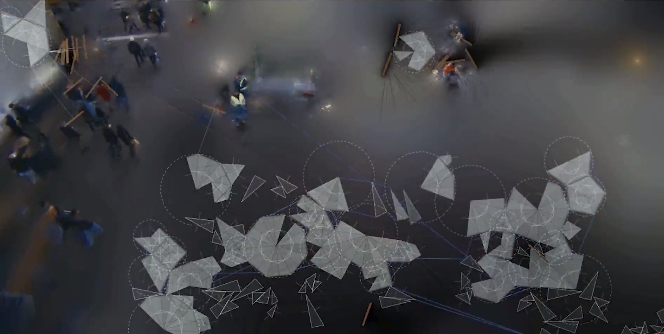報告者:吳永感
報告PPT: [PPT]
2018 ARS Electronica (Interactive Art)
作品名稱:Turnstile
作品作者:Ursula Damm (DE)
作品來源:作品連結(1)、(2)
作品說明:

Turnstile, an artwork installed at Schadowstraße underground station in Dusseldorf, selected in conjunction with a competition to artistically enhance the city’s Wehrhahn line.
Turnstile is designed as a snapshot of a location comprising pedestrians crossing the square above the underground station, a video camera observing the pedestrians, lifts transporting passengers to their platform, an LED wall situated above the rail lines at the front of the station plus 23 screens showing a birds-eye view of Dusseldorf interpreted as generated patterns.
The generative video on the front wall of Schadowstraße underground station captures the movements of pedestrians above ground and custom-made software interprets these movements as ‘energy sources’ or ‘virtual fuel’; consequently the temporal-spatial accumulation of events unfolding above the underground station is manifest on the screens installed on the station’s LED wall—ultimately becoming a virtual interpretation of the location’s lively hustle and bustle, modelled with the help of artificial intelligence. Small, virtual beings use the motion-energies to build a temporary, fluctuating architecture that ebbs and flows in accordance with the stream of passers-by. The artwork encompasses urban space and its geometries. Geometries define the earth up to a point; when humans settled, geometries were also used to map the near and far, the inside and outside, the you and I. In short: geometries map the physical coexistence of human beings.
Geometry orders habitats. It interprets, structures, and alters movement within a space; it is a component of the ‘language’ of habitats. It records the flow of movement, the swarm behaviour of humans within urban environments and the surrounding areas.
Our software follows a particular grammar: the interplay of local events, pedestrian activity, and social interaction becomes architecture. The diverse possibilities of the algorithmic performance soften the radical position geometry naturally holds and instead pose a hypotheses and make an offer to the citizen; an architecture that is formed from the actions of the passer-by. This is how the software builds an artificial intelligence on the basis of the geometric logic of an individual artistic approach.
Source: Excerpt from Turnstile – Ein polygonaler Kanon, first published in Zeitschrift für Herz-, Thorax- und Gefäßchirurgie, April 2018, Volume 32, Issue 2, pp 158–166, Springer Verlag, https://doi.org/10.1007/s00398-018-0207-0, English version: http://ursuladamm.de/site/wp-content/uploads/2018/02/Turnstile_Springer_engl.pdf
Keywords
Interactive Artwork, Digital Art, Activity Theory, Disruptive Aesthetics, Interactive Framework
